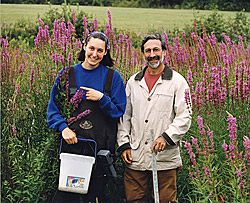|
Campus News
UAlbany Biologists Testing New
Ways to Map Purple Loosestrife
By Greta Petry (September 10,
2004)
 |
Doctoral student Anna
Hartwell and biology Professor Gary Kleppel
are tracking the effect of purple loosestrife
on wetlands in New York State through high-tech
remote sensing equipment. |
Biologists at the University at Albany are
developing high-tech ways to map the distribution
of plants like the ubiquitous purple loosestrife
in New York State wetlands.
Loosestrife is an invasive marsh plant from
Europe that crowds out native plants and alters
native ecosystems.
UAlbany Professor Gary Kleppel, director of
the Biodiversity, Conservation and Policy program
said, �We are studying the feasibility of using
hyperspectral remote sensing to monitor wetlands
in New York State for the Environmental Protection
Agency.�
Kleppel�s research is funded by a $320,000
grant from the Environmental Protection Agency
over two years.
�The remote sensing device, called a hyperspectral
scanner, is mounted on the underside of a twin
engine Apache and flown over two areas in New
York (Saratoga and Orange counties) where we
know there are many wetlands,� Kleppel said.
The pilot flies low � at about 1,100 feet �
over wetlands in the Town of Stillwater and
City of Mechanicville in Saratoga County, as
well as Luther Forest in Malta. Orange County
sites include Stewart Forest near Stewart Airport
and a site owned by the Audubon Society.
The scanner measures the amount of light coming
back from the earth in 37 spectral, or color,
bands.
�Some of these bands are invisible, near and
far infrared, but taken all together they can
tell us a great deal,� Kleppel said. �For instance,
it is believed that each plant species has a
unique spectral signature. If you can identify
that signature, you can, in theory, map that
plant�s distribution everywhere.�
UAlbany biologists are working with their colleagues
at Clemson University to identify the spectral
signature of purple loosestrife, which displaces
native marsh species and modifies ecosystems.
�How this will affect humans is not yet fully
understood, but wetlands are very important
for cleaning water, and anything that alters
that capacity has potential implications for
us because we drink water,� Kleppel said.
Kleppel�s fifth year doctoral student, Anna
Hartwell, 28, of Verona, N.Y., collected soil
from the wetland areas under study. The UAlbany
alumna earned a Master of Science degree in
biodiversity, conservation and policy with Kleppel
as her mentor.
She said, �The sites without many adult purple
loosestrife plants had few to no purple loosestrife
seedlings in the trays. But, in the trays of
soil from the invaded sites, more than 500 purple
loosestrife seedlings sprouted per tray. Other
plant species in the trays had from one to 100
seedlings per tray.�
Adult purple loosestrife plants can produce
two to three million seeds per plant; the majority
will germinate if grown in suitable conditions.
�These results show that not only does purple
loosestrife dominate in certain wetlands, it
also dominates the seed bank in invaded wetlands.
Once purple loosestrife is established, it is
very difficult to eliminate,� Hartwell said.
Just how does one get rid of the invading plant?
�Biological controls can be used to reduce purple
loosestrife populations. The main biocontrol
that is used is to introduce insects from purple
loosestrife�s native habitat that eat different
parts of the plant,� Hartwell said.
While Hartwell�s research provides much-needed
data on the mechanisms by which purple loosestrife
spreads and its effects on native marsh flora,
Kleppel and colleagues at Clemson University
are optimistic the unique spectral signature
they have identified for purple loosestrife
will allow them to map distribution of the plant
from the air.
�We are in the process of validating and �tuning�
the signature through an intensive ground truth
campaign,� Kleppel said. �So far, the spectral
�fingerprint� seems to be confirmed. In mid-August,
we replicated some earlier experiments by flying
the instrument over the same wetlands we flew
over last year. We want to determine how well
our observations can be repeated from one year
to the next,� Kleppel said.
The new technology makes monitoring largescale
wetlands feasible. There are too many wetlands
to appraise them the old-fashioned way � by
sending people into the field � and the abundance
of wetlands on private property renders them
less accessible.
�This project is contributing to a new direction
for technology at UAlbany,� Kleppel said. It
enables scientists to work on jobs too expansive
in scope for people to carry out alone. He concluded,
�A cadre of biologists, ecologists, meteorologists,
and geographers at UAlbany is well versed in
this technology and is gaining a good reputation
in remote sensing. I look forward to the day
when nano- and macroscience converge here, as
data from nanosensors deployed in the environment
are telemetered to satellites and then to receivers
here at the University.�
|
